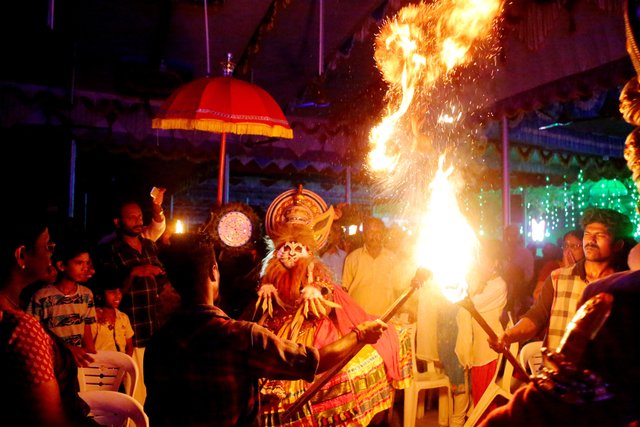INTRODUCTION
Kathakali which literally translates into performing a story is one of the oldest and world-famous Indian classical dances. The fact that many people from different nations are all attracted by this dance form is evident from their presence in the tiny state of Kerala in the academies that teach Kathakali.

It is believed to be 300 years old and this performance is a combination of drama, dance, devotion, music, makeup, and costumes which ultimately transform into a divine experience. Generally, stories that were played for Kathakali is based on Indian Myths or epics.
In addition to the way of performing this dance form and conveying the specific storyline to the audience through performance on stage, the most important features can be seen in the costume and makeup.
THE WAY OF PERFORMANCE
The audience would get to know the story through the intricate footwork of the artist, excellent movement of face and eyes along with the combination of different shapes shown through hands and fingers. This is complemented by music and vocal performance. This is having a distant similarity with other famous Indian classical dance forms such as Bharatanatyam, Mohiniattom too. Each movement of eyeballs, the lips, the speed of eyelids that closes and opens, and the different positions of fingers have its own significance in the play such that mostly older generation is the main followers of this dance.

THE MAKE – UP MAKES THE REAL DIFFERENCE
One of the most articulate and important aspects of Kathakali is its makeup. Different characters of a play are distinguished by the color code. There are mainly five types. They are Pacha (Green – Not to confuse with the original color of Green), Kathi, Minuku, Thaadi, and Kari (Black). Noble characters and Gods are represented by Pacha. Pacha can be identified by bright and red/Coral lips.
Minukku’s colors are mainly orange, saffron, or yellow to represent virtuous female characters. Kathi or Kathi uses for representing evil through a mixture of green and Red apart from the upturned mustache. Kari or Black also an important part of the makeup with the color black as the word itself means and they depict villainous characters such as demonesses, hunters, etc.
And the last main one is Taadi with the literal meaning of Beard. It uses colors in the beards to identify the people it represents. They are mainly white beard for superhuman monkey Hanuman. Hanuman is a famous and important personality in the Epic Ramayana and Red one for evil characters and Black one for hunters, etc.

The difference between makeup and clothing is usually only in the upper part of the body. While the lower part is also specially manufactured in its own traditional way. That is through specially made skirts which broaden out in a semi-circular shape. Pleated flexible inner parts also will make it a special way of dressing. It should be noted that it takes about 6 to 8 hours for each character to completely complete the makeup.
Jewelleries and ornaments normally are gilded breastplates, necklaces, bangles, and bracelets along with small bells in the strings tied around the ankles.
MUSIC IS THE SOUL
Music is considered to be the core of Kathakali performance for creating the mood of plays and particular scenes through variations of tone. The music instruments mainly using are also traditional ones that encompass three major drums known as “Itaykka, Chenda, and Maddalam“.
This traditional dance form is so special that it requires anywhere between nearly 10 to 12 years of full time, dedicated training to learn the gestures and choreography.
WHY THIS POST NOW: As I was surfing through my gallery I saw some photographs of a performance I watched. Just want to share with my readers. So more photographs will be included in the Photo Feature section soon



I find Kathali amusing in itself. However, I never really paid attention to the intricacies that goes into making it for what it is. Thanks for sharing such an informative post.
LikeLike
This is so fascinating! I love the use and meaning behind the different colors. I’m American Indian and it really makes me think of the dancing at pow wows and rum circles
LikeLike
I was not aware that it’s 300 years old. Really surprised and appreciate that they preserved their culture so long.
When I was a child, I was watching a performance at Doordarshan and remember the host was describing how difficult to perform it. They do lots of hard work before and during the performance.
LikeLike
I would love to experience this dance! Sounds like there are so many facets, the colours, meanings…I would love to visit India some day.
LikeLike